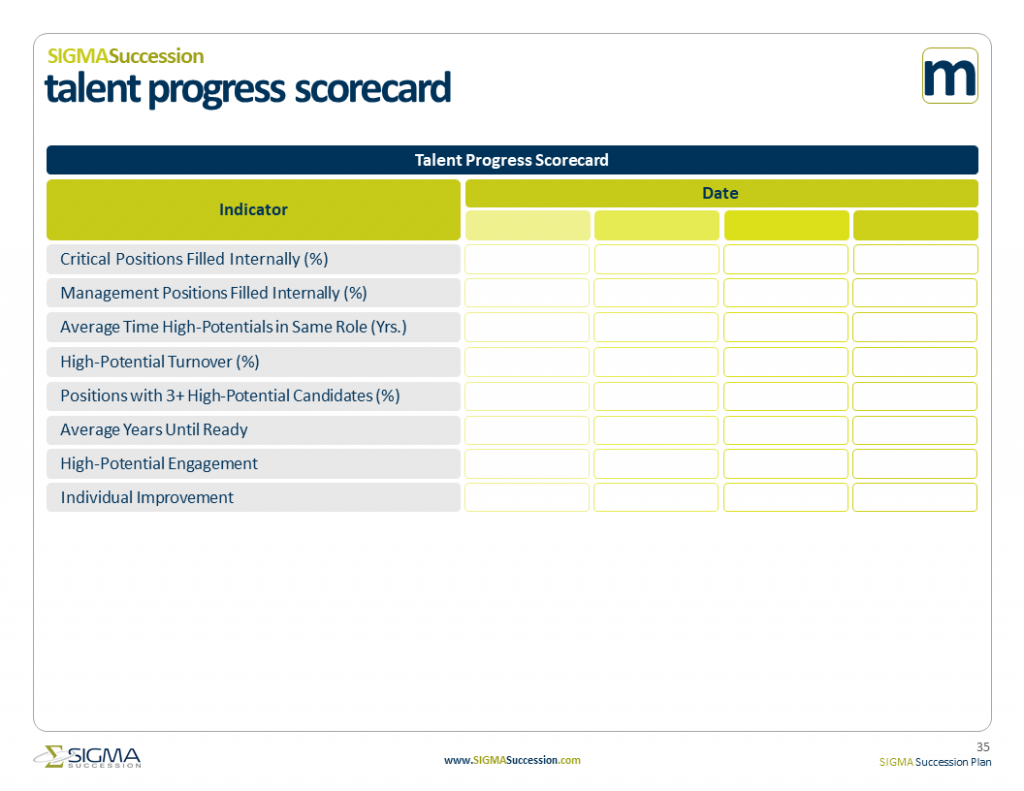Evaluate the Impact of Succession Planning
Evaluate the Effectiveness of Your Succession Plan
Measure the Full Impact of Succession Planning in Your Company
Evaluating the success of any company-wide intervention is one of the most important steps to understanding its effectiveness. It’s also, however, one of the most overlooked parts of the process. Luckily, it can be simple to evaluate the impact of your succession planning, and SIGMA provides you with the tools you need to measure your success.
How to Measure the Impact of your Succession Plan
Step 1: Use Metrics to Measure Success That Reflect Your Company Goals
The success of your plan will depend heavily on the measures you focus your attention on. The metrics you choose should reflect the goals of your succession plan, so be sure these are clearly defined and stated as part of your formal succession plan. There are two kinds of metrics you might consider when you evaluate the impact of your succession planning process:
Objective Metrics for Quantitative Measurement
Objective measures are those metrics you can put hard numbers to. These are often very compelling to various stakeholders, especially executive boards or investors. For instance, some of the most common examples include the percentage of positions you are able to fill internally, or the number of years it takes for the average candidate to be ready for a new role. These are often the targets of succession goals, and are generally reflected in your bottom line. Look to the data you already collect on hiring, promotions, and personnel retention for some ideas on where to get started.
Subjective Metrics for Qualitative Measurement
Subjective metrics are based on less easily-defined measures of success. They are often reflective of the way succession planning impacts employees and your company’s culture on a day-to-day basis. For example, some of the most common metrics include employee engagement and job satisfaction. Many companies already conduct engagement and satisfaction surveys, and these are a great source of data. You might also consider trying to evaluate how succession impacts your employees directly, including their personal development and the quality of the relationships they have with their leaders as a result of regular development conversations.
Regardless of the measures you choose, we recommend you decide early in the process and gather baseline data so you can see the true impact succession planning has on your company. Use our Talent Progress Scorecard to help guide your measurement.

Note, the metrics included on this scorecard are commonly used measures, but they should be considered suggestions. Companies can and should customize their metrics to fit their needs. Above all, be sure to include a balance of objective and subjective measures to gain a more comprehensive picture of your success.
Step 2: Update Your Talent Progress Scorecard
The Talent Progress Scorecard should be updated regularly. Succession planning is a long-term process, which means it can have a long-term positive impact. It’s not enough to review a metric or two once and consider your plan a success or a failure. Schedule time in your calendar every six months to gather and summarize the data on your Scorecard. Remember that the on-going talent development and employee growth inherent in a robust succession plan takes time, so you will be seeing the benefits of succession for years to come.
Step 3: Communicate The Results
Given that succession planning requires the engagement and efforts of employees at all levels of the organization, it’s important that the results of the process are shared widely. Communicating your results, regardless of what they say, demonstrates your commitment to succession planning and signals to your employees that it remains a priority for your company. Finally, consider distributing the numbers to your management team, executive board, investors, and employees alike.
How SIGMA Can Help
At SIGMA, we want to help your company create a succession plan made for success. Our Launch Series will deliver your organization a personalized succession plan in just four to six weeks and includes all the metrics you need to watch your plan succeed. For more information on our SIMPLE Succession Process, Succession Planning Launch Series, or Succession Planning solutions, contact us and learn more about how we can help your organization plan for the future.